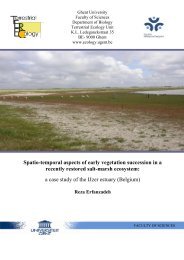PhD Arthur Decae 2010 - Ghent Ecology - Universiteit Gent
PhD Arthur Decae 2010 - Ghent Ecology - Universiteit Gent
PhD Arthur Decae 2010 - Ghent Ecology - Universiteit Gent
You also want an ePaper? Increase the reach of your titles
YUMPU automatically turns print PDFs into web optimized ePapers that Google loves.
that the characters Simon used are highly constant within Cyrtocarenum and therefore are<br />
potentially good diagnostic characters. The morphology of the rastellum in Cyrtocarenum<br />
however, is virtually identical to what I have seen in Cteniza and therefore cannot be used to<br />
distinguish the three genera. On the other hand, from the sparse material of Cteniza and<br />
Aepycephalus that I have seen, the differences in configuration of the eyes between the three<br />
genera seem distinct (Figs. 1-3). Whether these differences should be considered as definite<br />
diagnostic characters at the genus level remains to be investigated. Although the question of<br />
the generic identity of Cyrtocarenum lies largely outside the scope of the study presented<br />
here, I will give a preliminary key for Mediterranean Ctenizinae (sensu Raven 1985). Raven<br />
(1985: 142) questions the separate identity of the three genera by stating that it is only the<br />
poor availability of material that prevents him from proposing the synonymy of Cteniza,<br />
Aepycephalus and Cyrtocarenum. Notwithstanding the differences in eye configuration, I am<br />
inclined to agree, although awaiting a more detailed study of the taxonomy in this group of<br />
spiders I will use Cyrtocarenum for the Ctenizidae (sensu Raven 1985) occurring in Greece 26 .<br />
Measurements, abbreviations and terminology<br />
Measurements of the carapace, sternum and eye-group were performed with the specimen in a<br />
horizontal dorsal or ventral position under the microscope. Measurements of leg and palp<br />
segments were made along the retrolateral surface of detached appendages placed in a<br />
horizontal position as illustrated in Figs. 6-7. A1l measurements were made using a Wild<br />
stereomicroscope equipped with an eyepiece micrometer and are accurate to 0.1 mm.<br />
Abbreviations used (see also Figs. 1-7, 16, 17): REF=width/height ratio of eye formation;<br />
RPT = TL/TW (see Fig. 6) ratio of male palpa1 tibia; RBE = bw/el (see Fig. 6) ratio of palpal<br />
organ; CL = carapace length; CW = carapace width; SL = sternum length; SW = sternum<br />
width; FL = femur length; PL = patella length; TL = tibia length; TW = tibia width; ML =<br />
metatarsus length; TaL = tarsus length; p = pa1p; I = leg I; II = leg II, III = leg III; IV = leg<br />
IV; ax = axis; bc =bursa copulatrix; bw = bulbus width; co = constriction; cv = closure valve;<br />
ef = epigastric furrow; el = embolus length; pl = prolateral; r = receptaculum; rl = retrolateral.<br />
BMNH = Natura1 History Museum, London; FSF = Forschungsinstitut Senckenberg,<br />
Frankfurt; MNHN = Muséum Nationa1 d' Histoire Naturelle, Paris; NHMW =<br />
Naturhistoriches Museum Wien; NNML = Nationaal Natuurhistorisch Museum, Leiden. The<br />
pattern, presence and absence of various types of setae is important in the description and<br />
recognition of the species of Cyrtocarenum. The following terms are used: hook = massive<br />
setiform structure associated with the leg claspers in males (Figs. 22-23); spines = macro<br />
setae that occur on all appendages (Fig. 13); short spines = setiform structures as illustrated in<br />
Fig. 14; spiny setae = conspicuously long strong setae that occur on some 1egs (e.g. on femur<br />
III and IV of the spiders illustrated in Figs. 18-19) and on the cymbium of C. grajum (Fig.<br />
21); setae = hair-1ike cover of most body parts (Fig. 15); teeth = strong and rigid structures in<br />
the rastellum and much smaller structures lining the cheliceral furrow; denticles = knob-like<br />
structures within the cheliceral furrow; cuspules = knob-like structures on maxillae and<br />
labium.<br />
Material examined<br />
The Cteniza and Aepycephalus material examined is all in the collection of the MNHN and<br />
consists of 4 specimens labelled Cteniza sauvagesi, (Rossi 1788), 7 specimens labelled<br />
Cteniza moggridgei O. P. Cambridge 1874, one specimen labelled Aepycephalus brevidens<br />
26 On the basis of new data (<strong>Decae</strong> <strong>2010</strong>) the distinct generic status of Cteniza and Cyrtocarenum is confirmed on the<br />
clasping organs on the male tibia I absent in Ctenzia, present in Cyrtocarenum.










